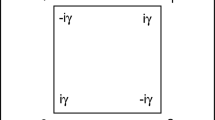Abstract
By applying the representation theory of Y(sl(2)) to Hydrogen atom (HA) the correct spectrum are re-derived. This indicates the consistence between HA and the Yangian algebraic structure and guarantees that there is democracy between angular momentum L and Yangian current J in the sense of conserved currents. The physical effect of Yangian in HA has been predicted that preserves all the known results for HA, but gives rise to abnormal intensities in the spectrum lines near the free state.
Similar content being viewed by others
REFERENCES
V. Drinfel'd, Sov. Math. Dokl. 32:254 (1985).
V. Drinfel'd, Quantum Group (PICM, Berkeley, 1986), p. 269.
V. Drinfel'd, Sov. Math. Dokl. 36:212 (1985).
A. Belavin, Phys. Lett. B 283:67 (1992).
M. Jimbo (ed.), Yang-Baxter Equations in Integrable Systems (World Scientific, Singapore, 1990).
R. Baxter, Exactly Solvable in Statistical Mechanics (Academic, London, 1982).
P. P. Kulish, I. K. Sklyanin, Lecture Notes in Physics 151:1 (1982).
V. E. Korepin, N. M. Bogoliubov, and A. G. Izergin, Quantum Inverse Scattering Method and Correlation Function (Cambridge Univ. Press, Cambridge, 1993).
V. Chari, A. Pressley, Yangian and R-matrix, L'Enseignement Mathématique 36:267–302 (1990); A Guide to Quantum Groups (Cambridge Univ. Press, Cambridge, 1994).
F. D. M. Haldane, Phys. Rev. Lett. 60:635 (1998).
S. Shastry, Phys. Rev. Lett. 60:639 (1988).
F. D. M. Haldane, Physics of the ideal semion gas: spinions and quantum symmetries of the integrable Haldnade-Shastry spin-chain, in Proc. 16th Taniguch Symp. on Condensed Matter (Springer, Berlin, 1994).
D. B. Uglov and V. E. Korepin, Phys. Lett. A 190:238 (1994).
F. Gömann and V. Inozemtsev, Phys. Lett. A 214:161 (1996).
M. L. Ge, K. Xue, and Y. M. Cho, Phys. Lett. A 260:484 (1999).
M. L. Ge, K. Xue, and Y. M. Cho, Phys. Lett. A 249:358 (1998).
V. I. Anol'd and S. D. Novikov, Encyclopaedia of Mathematical Sciences, Vol. 4, Part IV: Dynamical Systems (Springer, Berlin, 1985) pp. 180–183.
T. T. Wu and C. N. Yang, Nucl. Phys. B 107:365 (1976).
Author information
Authors and Affiliations
Rights and permissions
About this article
Cite this article
Bai, CM., Ge, ML. & Xue, K. Further Understanding of Hydrogen Atom: Yangian Approach and Physical Effect. Journal of Statistical Physics 102, 545–557 (2001). https://doi.org/10.1023/A:1004834516013
Issue Date:
DOI: https://doi.org/10.1023/A:1004834516013




